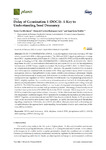Mostrar o rexistro simple do ítem
Delay of germination-1 (DOG1): a key to understanding seed dormancy
| dc.contributor.author | Carrillo Barral, Néstor | |
| dc.contributor.author | Rodríguez-Gacio, María del Carmen | |
| dc.contributor.author | Matilla, Angel Jesús | |
| dc.date.accessioned | 2020-05-20T10:49:01Z | |
| dc.date.available | 2020-05-20T10:49:01Z | |
| dc.date.issued | 2020-04-09 | |
| dc.identifier.citation | Carrillo-Barral, N., Rodríguez-Gacio, M. del C., & Matilla, A. J. (2020). Delay of Germination-1 (DOG1): A Key to Understanding Seed Dormancy. Plants, 9(4), 480. doi:10.3390/plants9040480 | es_ES |
| dc.identifier.issn | 2223-7747 | |
| dc.identifier.uri | http://hdl.handle.net/2183/25602 | |
| dc.description.abstract | [Abstract] DELAY OF GERMINATION-1 (DOG1), is a master regulator of primary dormancy (PD) that acts in concert with ABA to delay germination. The ABA and DOG1 signaling pathways converge since DOG1 requires protein phosphatase 2C (PP2C) to control PD. DOG1 enhances ABA signaling through its binding to PP2C ABA HYPERSENSITIVE GERMINATION (AHG1/AHG3). DOG1 suppresses the AHG1 action to enhance ABA sensitivity and impose PD. To carry out this suppression, the formation of DOG1-heme complex is essential. The binding of DOG1-AHG1 to DOG1-Heme is an independent processes but essential for DOG1 function. The quantity of active DOG1 in mature and viable seeds is correlated with the extent of PD. Thus, dog1 mutant seeds, which have scarce endogenous ABA and high gibberellin (GAs) content, exhibit a non-dormancy phenotype. Despite being studied extensively in recent years, little is known about the molecular mechanism underlying the transcriptional regulation of DOG1. However, it is well-known that the physiological function of DOG1 is tightly regulated by a complex array of transformations that include alternative splicing, alternative polyadenylation, histone modifications, and a cis-acting antisense non-coding transcript (asDOG1). The DOG1 becomes modified (i.e., inactivated) during seed after-ripening (AR), and its levels in viable seeds do not correlate with germination potential. Interestingly, it was recently found that the transcription factor (TF) bZIP67 binds to the DOG1 promoter. This is required to activate DOG1 expression leading to enhanced seed dormancy. On the other hand, seed development under low-temperature conditions triggers DOG1 expression by increasing the expression and abundance of bZIP67. Together, current data indicate that DOG1 function is not strictly limited to PD process, but that it is also required for other facets of seed maturation, in part by also interfering with the ethylene signaling components. Otherwise, since DOG1 also affects other processes such us flowering and drought tolerance, the approaches to understanding its mechanism of action and control are, at this time, still inconclusive. | es_ES |
| dc.language.iso | eng | es_ES |
| dc.publisher | MDPI | es_ES |
| dc.relation.uri | https://doi.org/10.3390/plants9040480 | es_ES |
| dc.rights | Atribución 3.0 España | es_ES |
| dc.subject | DOG1 | es_ES |
| dc.subject | Seed dormancy | es_ES |
| dc.subject | ABA | es_ES |
| dc.subject | Ethylene | es_ES |
| dc.subject | Clade-A PP2C phosphatase (AHG1; AHG3) | es_ES |
| dc.subject | After-ripening | es_ES |
| dc.subject | AsDOG1 | es_ES |
| dc.subject | Heme-group | es_ES |
| dc.title | Delay of germination-1 (DOG1): a key to understanding seed dormancy | es_ES |
| dc.type | info:eu-repo/semantics/article | es_ES |
| dc.rights.access | info:eu-repo/semantics/openAccess | es_ES |
| UDC.journalTitle | Plants | es_ES |
| UDC.volume | 9 | es_ES |
| UDC.issue | 4 | es_ES |
| UDC.startPage | 480 | es_ES |






